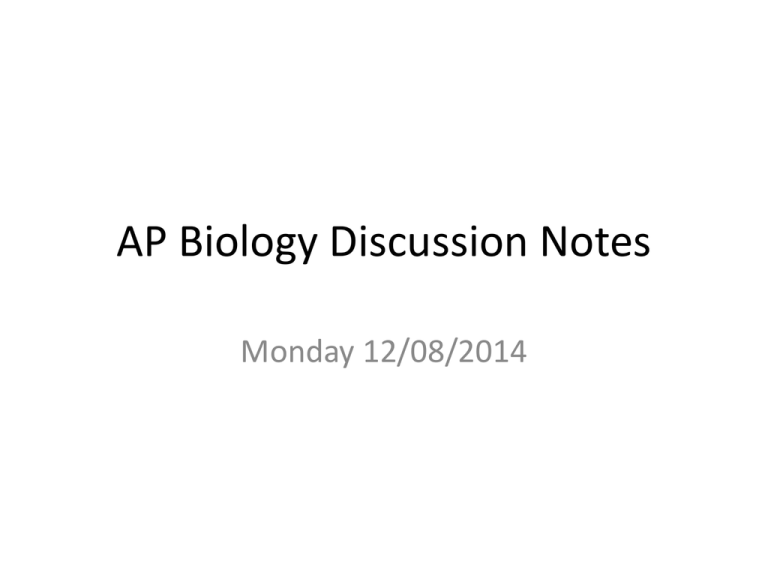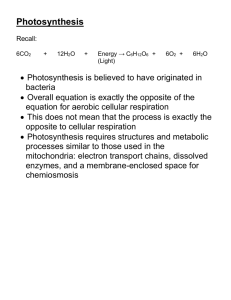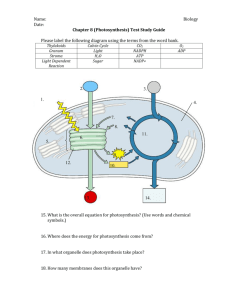AP Biology Discussion Notes
advertisement

AP Biology Discussion Notes Monday 12/08/2014 Goals for the Day 1. Be able to write a chemical equation for photosynthesis (and understand its complexities) 2. Be able to describe the two parts of photosynthesis 3. Be able to describe the importance of the photosynthetic process. Question of the Day 12/08 What is the difference between Heterotrophs & Autotrophs? Give examples of each. Autotrophs vs. Heterotrophs • Autotroph • Heterotroph Figure 10.2 Photoautotrophs (b) Multicellular alga (a) Plants (d) Cyanobacteria (c) Unicellular protists 10 m (e) Purple sulfur 1 m bacteria 40 m Photosynthesis _________ energy ________energy Is this important? The MIRACLE OF LIFE! Inorganic Organic Fossil Fuel • What is a fossil & what does “fossil” fuel mean? • Is this a renewable resource? • Where did the chemical energy in fossil fuels originally come from? Alternative BioFuels Alternative BioFuels What major plant part is responsible for photosynthesis? Mesophyll cell (inner leaf) may have 30-40 chloroplasts in each Cell! Where did chloroplasts come from? (What theory is this?) • What evidence is there for that? • What kind of cells have chloroplasts? The Mighty Chloroplast The Skeleton of a Chloroplast Membranes allow cells to do what? • Movement in/Out • ORGANIZATION • Build a Gradient – DO WORK SUMMARY Chemical Equation for Photosynthesis CO2 + H2O C6H12O6 + O2 Van Niel – 1930s • Studies mechanism of photosynthesis in bacteria that do not produce Oxygen. • Wanted to know where the Oxygen produced in Photosynthesis comes from. Van Niel – 1930s • Studies mechanism of photosynthesis in bacteria that do not produce Oxygen. CO2 + 2H2S [CH2O] + H2O+2S Van Niel – 1930s • So where must the oxygen come from? CO2 + 2H2S [CH2O] + H2O+2S Figure 10.5 Reactants: Products: 6 CO2 C6H12O6 12 H2O 6 H2O 6 O2 Photosynthesis in 2 Stages • Light reactions (light dependent reactions) – done in the thylakoid membranes • Calvin Cycle (light Independent reactions) – Done in the stroma Light Reactions • Light + H2O NADPH + ATP + O2 • Water supplies Electrons and Hydrogen ions that will power chemiosmosis and Phosyphorylation of ADP to ATP. Calvin Cycle • CO2 Carbohydrate • Recycles ADP/NADP+ The MIRACLE OF LIFE! Inorganic Organic Figure 10.6-1 H2O Light NADP ADP + Pi Light Reactions Chloroplast Figure 10.6-2 H2O Light NADP ADP + Pi Light Reactions ATP NADPH Chloroplast O2 Figure 10.6-3 CO2 H2O Light NADP ADP + Pi Light Reactions ATP NADPH Chloroplast O2 Calvin Cycle Figure 10.6-4 CO2 H2O Light NADP ADP + Pi Light Reactions Calvin Cycle ATP NADPH Chloroplast O2 [CH2O] (sugar) Reading Assignment • Already started Chapter 10 Notes • Start on page 192 – Think about what you are doing! – Draw figures – Read and then summarize – Leave yourself room to add information Business • Turn in: CELL RESPIRATION LAB • Finish 10.2 Notes (through 197) for tomorrow • Know that we will take notes through 10.3, so if you prefer to read that at home or want to start doing that GO RIGHT AHEAD! Species of the day 12/08 • Volvox (Algae) -Volvox carteri Species of the day 12/08 • Volvox (Algae) -Volvox carteri Does this photosynthetic Algae still need to do Cellular Respiration? Explain






